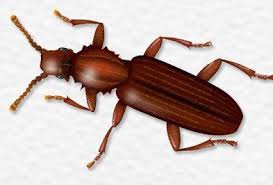Sawtooth Grain Beetles scientifically known as “Oryzaephilus Surinamensis” are the beetles that are often confused with the Merchant Grain Beetles. These pests vary in size from 2.5mm to 3mm. Their body is flat and is packed with short antennas and six tiny projections, precisely behind the head. Their lifecycle is a sum of four stages, starting from the egg stage and ending at an adult stage. At their adult stage, they turn into dark brown beetles. According to the research, it’s found that the female sawtooth beetle can lay up 375 eggs.
Sawtooth grain beetles have a debility of flying, and they’re not attracted to light. These beetles do not prefer high greasy products such as copra and nuts but love to eat pet foods, cereals, bird seeds, dry fruits, beans, and peas. These beetles can penetrate stored foods and can foul food by leaving waste and laying eggs. They’re mostly found in Spence, warehouse, food processing areas, and homes.
We’ve compiled some interesting facts, infestation, lifecycle, and traps regarding Sawtooth Grain Beetles, during this article. Therefore, proceed reading further for more clarity.

Sawtooth Grain Beetle Infestation
Sawtooth grain beetle infestation usually begins when someone brings infested food bags in their house. These pests can quickly immerse other food items such as cereals, grains, beans, and peas. However, these pests are not as dangerous as they don’t bite or sting, but they can become a source of irritation if not controlled immediately. It’s seen that beetles infestation often causes mold issues due to moisture increment. Also, the sawtooth beetle’s set off from the pantry and settle to nearby houses, once they reach their adult stage. This results in the exponential growth of these pests.
Sawtooth Grain Beetle Facts
Below you’ll find some interesting facts about Sawtooth Grain Beetles.
- Sawtooth grain beetles are the beetles that are often confused with the Merchant grain beetles.
- Sawtooth grain beetles are scientifically known as “Oryzaephilus Surinamensis”.
- Sawtooth grain beetles are usually dark brown with six projections similar to a sawtooth.
- Sawtooth grain beetles vary in size from 2.5mm to 3mm.
- Sawtooth grain beetles have the debility of flying; therefore, they crawl in search of their food.
- Sawtooth grain beetles infestation causes mold issue due to increment in moisture.
- Sawtooth grain beetles love to eat pet foods, cereals, bird seeds, dry fruits, beans, and peas but don’t like high greasy products such as copra and nuts.
- Sawtooth beetles are not attracted to light; instead, they prefer warm and dark places such as cabinets, Spence, and food processing areas.
- Sawtooth beetles produce cocoon from food crumbs when they reach to the elder stage.
Sawtooth Grain Beetle Life Cycle
Like other beetles, sawtooth beetle’s life also comprised a sum of four stages. The first is the egg stage, where female beetles lay eggs in demolished food items. The second is the larvae stage where larvae hatch from the egg and are inclined towards their feed. The third is the pupae stage where the mini beetles work hard with their transformation and make a cocoon from food crumbs. The last comes to the adult stage, where the mini beetle is ready to face further challenges. In warm and humid conditions the entire lifecycle of sawtooth beetles takes up to 2 months. These beetles overgrow, so it’s vital to break their chain.
Sawtooth Grain Beetle Traps
Sawtooth Beetles can be dogged into your houses and pantries if their lifecycle is not split. Therefore, some traps for these irritating creatures need to be adopted. Various traps for open areas, Spence, and home cabinets are available in the market. All you need is to buy them immediately so that their chain can break. Some useful traps that can control the infestation caused by these pests are surface cabinet beetle traps, hanging cabinet beetle traps, and lure beetle traps. First check out where the main junction of these pests is, then accordingly place the traps. These traps attract beetles and work efficiently for their disintegration. All you need is to fill the trap with the given liquid that contains catching gel for the beetles then place it to the corner where the beetle’s infestation is observed. Sawtooth beetles will roam towards the catching gel that contains thickening oil which will catch these irritating beetles. The traps stay for 60-90 days. That seems to be enough for the disintegration of beetles, but if there’s an enormous amount of beetles, then you need to replace it.


